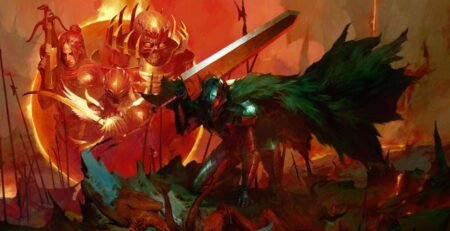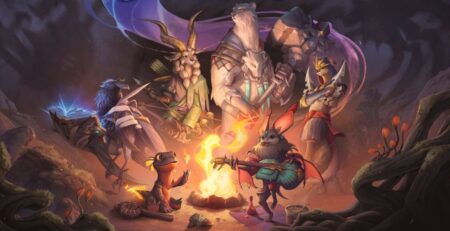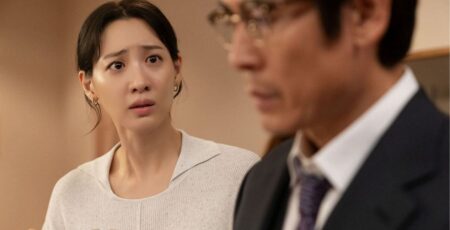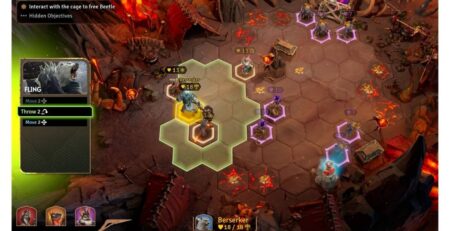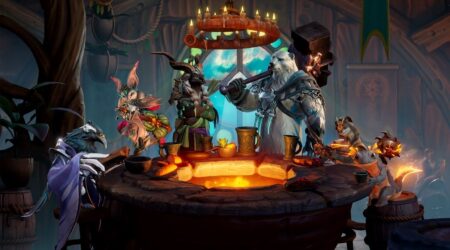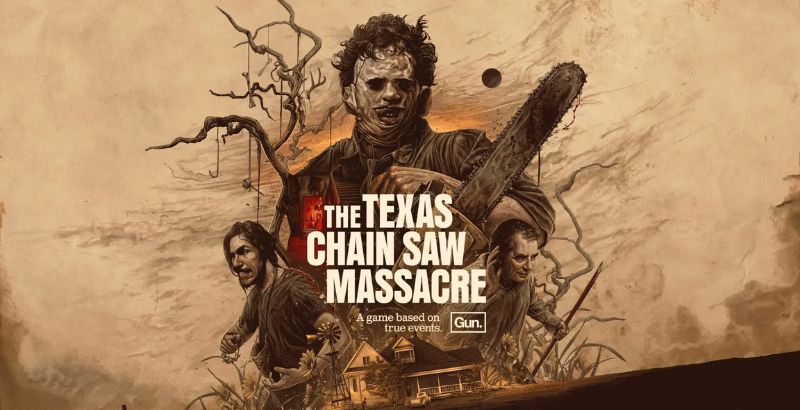
The Texas Chain Saw Massacre, developed by GUN and SUMO Digital – Nottingham, isn’t just bringing a slasher IP to life, it’s bringing Texas to the video game through language, landscape, and more. If you’re not familiar, Texas Chain Saw Massacre kickstarted the slasher genre in 1974. It also created mythos around small Texas towns that has stuck with us until today, and to be honest, it’s one of the best things about our state. Now, players get the chance to play through The Texas Chain Saw Massacre game as either a member of the Family or the Victims, working to feed Grandpa or to survive and escape. A mainstay in asymmetrical multiplayer games, GUN has already brought one iconic franchise to life with Friday the 13th The Game, and now we get the chance to enter the one that started it all with The Texas Chain Saw Massacre—based on true events, of course.
At the pre-launch party for The Texas Chain Saw Massacre, we got the chance to sit down with GUN’s Creative Director Ronnie Hobbs, horror actor Damian Maffei, the voice of Johnny, and horror legend Kane Hodder, about the game, and what its like to bring what has become a vital part of horror and Texas mythos to life.
This interview has been edited for length and clarity, to hear our full Texas Chain Saw Massacre conversation which includes commentary and conversation with horror legend Kane Hodder and Hobbs and Maffei, hit play on the player above.
BUT WHY THO: So my first question is for both of you, why Texas Chainsaw Massacre? What attracted you, Damian to bring Johnny to life and you, Ronnie, to pick this title to work with?
DAMIAN MAFFEI: Well, Ronnie came up to me and said, “Would you like to do the voice in Texas Chain Saw Massacre?” And I was like, “Am I on one of these prank shows?” Horror and video games, come on. Do I pay you? I mean, that’s pretty much all I need. That’s all it took.
RONNIE HOBBS: Mine is gonna be a little longer. I’ve told this story before, but the first time I saw Texas Chainsaw Massacre, I was probably nine years old. So way, way too early to be watching that film. But I remember everything about [that day], where I was, what I was wearing, and all my friends. We were in this little basement that had gravel—like it was not a place we would be watching a horror film when you’re a kid. We rented a VCR and stole someone’s TV from our family ran down there, and watched it. And ever since that day, it’s just been a film that just stuck with me. Just like Friday the 13th, Halloween, and Nightmare on Elm Street, all of those horror films growing up. They’re part of our childhood.
And being in the video game industry. Of course, we already made Friday the 13th The Game, so next on my personal bucket list was obviously The Texas Chain Saw Massacre, not only just because I love it, but because it also allowed us to kind of push the [asymmetrical horror] genre forward. Friday the 13th was one killer, this [game] is three killers at a time. And of course, there are only a few franchises that will actually let you have multiple killers…But the Texas Chainsaw has the family. They have this dysfunctional comedic act between them…It’s an awesome environment in a twisted kind of black comedy kind of way. So it matches perfectly with our gameplay and then what we wanted to do within the genre.
BUT WHY THO: Have you played Johnny in the game in order to get into your voice acting set? How did you build a character out vocally?
DAMIAN MAFFEI: At the point of recording the dialogue I had not played as Johnny. But I had seen some sketches and drawings of them, and there was there Ronnie who provided a lot of inspiration kind of influence for them. So you know, I had a little research work to do before taking him on.
RONNIE: Yeah, if you didn’t know, Johnny is “Pretty Boy Johnny,” because he’s got a nice scar. The Family kind of makes fun of him and he’s one of the new characters along with Sissy Sunshine Slaughter. They’re two of the new characters we’ve worked with Kim Henkel to create. So the first time I spoke to Damian was several years ago. And at that point, we only had the mocap done for Johnny, but we didn’t have it completed, and we didn’t have the whole character model done. But that was when we were writing the script for all the lines. And there was this whole cadence on how serial killers talk. We studied multiple serial killers for him. So really, Johnny’s has Richard Ramirez and Ted Bundy, those kinds of guys, even with a Southern kind of twang. We found research documents from, like, the 1950s words. They were only used in Central Texas, we found these massive amounts of research done by universities about this Louisiana-Texas mix of southern hospitality. We took that and wrote the script and sent him all that and sent him the look of the character so that he could get into it. Of course, he said yes. And then he put his own spin on it.
BUT WHY THO: Now that there’s a tech now we have the tech task. We have the demo downstairs. Have you gotten to play is Johnny and what is your favorite thing about playing is Johnny?
RONNIE HOBBS: I won’t let him. I mean, I’ve been dragging him away all day.
DAMIAN MAFFEI: But I have been harassing people to play as Johnny, so keep getting him represented—I like that arrogance. That’s what’s the most fun to do that kind of arrogance which usually gets your villains in trouble. Their arrogance is what brings them down. But, you know, that remains to be seen per match. There is confidence in what he’s doing because he’s really likes to play with his food. That’s what’s so delicious about doing that kind of part…
BUT WHY THO: From a perspective of moving from any sort of acting in film, whether it physicality, or you know, vocally but moving into the voice-over space, is there any difference between what you bring to your role in a live-action versus what you bring to your role now doing voiceover?

DAMIAN MAFFEI: [Johnny] was the first voice acting I had done. I had done an audiobook right before that and of course, ADR, which is just usually the miserable affair for movies…I had to adapt to while I was doing [the voiceover]…because I started in theater and you have to project your voice and then went to film, and you got to tone it down. And then you go back to the theater, and it’s like, “we can’t hear you.” So then voice acting, I wanted to have that kind of growly thing [in my voice] for this great line where Johnny says, “You’re all girdleno guts.” I really want to keep that, like, kind of a growly thing but you know he’s talking to [people] 50 to 100 feet away. So, I’m in the recording studio, and the director is like “You have to be louder.” And I ask, “Can’t you just turn the volume up?” So then my voice is getting higher and higher. [imitates voice cracking while yelling]…That was very difficult for me. Yeah, because that was one of the biggest obstacles for me. It’s kind of keeping that menace without being like, come back here [in a cracking voice].
KANE HODDER: Can I ask a question? Did you adlib any lines?
DAMIAN MAFFEI: No!
RONNIE HOBBS: I am too much of a control freak for that. I didn’t let anyone improvise anything on the script. I just studied, and every line was written perfectly after I studied. It was all very specific dialogue. Every now and then though, like we change a word, but every word was [chosen] on purpose. The way that they speak out of turn and or mix up words, you know, that whole Southern thing like, “Don’t you think I know what you come here looking for?” Instead of just saying, “I know why you’re here.”
BUT WHY THO: Hearing your talk like there is an authenticity to the type of way that we speak in certain regions of the country. I do want to hear more about getting the language right because I think there’s an assumption of what Texans sound like without understanding that Texas is a large place with different dialects.
RONNIE HOBBS: Texas is broken up. So North Texas does not sound like South Texas, the middle Texas is a hub of many different styles. And of course, you have like the Texas Czech towns like Burne and all those. That influenced a lot of just general language to begin with and a lot of it is actually mixed with Kentucky and Tennessee. So people migrate south, and they bring their language with them. A lot of the lines are from my grandparents, and I’m from the middle of nowhere. That’s how they spoke, nothing made sense, but only to us, right? And there’s just certain language, certain words, that only means something if you know…It’s very authentic. Because, you know, I’m sure your grandparents had some things that, that you have a word that you’re like, ‘Wait, what’s that mean?’ So if you say it now, no one knows what the hell you’re talking about. Right? Because it’s a very specific thing to your family.
Kim Henkel, when he wrote the original script, he couldn’t remember the person’s name, but the famous guy in Texas that he used was a radio broadcaster that he based the entire dialogue on. He had this very weird twang way of speaking. Texas has a drawl and a twang exactly…And, of course, each character has their own personality.
Sissy, because she’s out, you know, roaming, rebelling against the family, going and hanging out with cults like the Manson Family and moving around, she has a unique way of speaking [compared to her family]. If you ever heard of Manson girls talk, they’re very kind of aloof. Speaking in high-level stuff that makes sense, but doesn’t at the same time, like “You’ll see the light,” and then you hear it and you’re like “what are we talking about?” She’s picking up things from California and she’s bringing it back. The Hitchhiker, I mean who knows what he’s talking about half the time.
But Johnny was very concentrated because I had references and it was how serial killers talk to people. And specifically, if you watch Mindhunter, where [serial killers are] talking…Some of the ones from Texas in the South you can just tell the difference. We started a lot of stuff like that to get the coldness of Johnny. And mix it with some twang and drawl talking to people like they’re nothing, like they’re pieces of meat and taunting them.
But they were all based on a University of Texas study that was put out maybe ten years ago, like 600-page PDF, and it broke down every word used specifically in the middle of Texas region. And the years that they faded away. I tried to stay [true to] words that were within the ’50s and ’60s because the game takes place in 1973, but they would have learned these words, in 1970 and ’65, and ’60 and ’55 when they’re born for their whole life. Of course, we put our funny stuff in there but it’s quite a while of this research, and we wanted to get it right. You know, or at least as close to right as you can possibly conceive. Because really, no one would know the difference at the end of the day, but we’re trying to get the house down to the blueprint, we’re definitely gonna go the extra yard on the voices too.

BUT WHY THO: So, when it comes to Leatherface and bringing him to video games and bringing him visually to life, what did you know you had to get right? How did you envision a player playing as Leatherface?
RONNIE HOBBS: So obviously, Leatherface is that weird character because he has to be the strongest. But if you make him so awesome, no one wants to play as anyone else. So either, you make him awesome and then try to bring the family up to speed and catch him, which is tough with the Cook, because he’s slow and stuff. So it’s a fine balance between keeping him original to exactly what he could do in the movie and not making him superhuman. Really, that was the key was that we wanted him to come to us.
You don’t you see him, you know, he’s there, he’s not gonna disappear on you. Right, exactly. So we needed to make sure he could open up new pathways like break doors down, saw them down, there’s a reason he can turn the chain, so on and off, because we wanted you to be able to play stealthily, if you wanted his Leatherface to hide and wait and scare people with it the last second the chainsaw will break and overheat and things like that, because that’s what they do in real life, right? So we really wanted to just ground him reality and keep him primitive but powerful. So that was the kind of the vibe for him. And of course, we want to get every inch of him right like the mask. And, you know, the pretty woman in the old lady costumes are in there.
There is just not a lot of references, by the way…They only show three rooms in the house. So yeah, we did go there and saw the blueprints, got personal tours, we’ve been to all the places, but recreating stuff from the 70s is far more difficult than doing something [like Friday the 13th] just because of the time period. That includes Leatherface’s clothes, and you know how they looked on film, it’s not how they really looked in real life, you know? Then of course, it was about bringing Kane into play. So as you know, Kane was Jason for us. And we knew about his work ethic. And we knew that he’s a stunt guy, and he, you know, can handle anything we threw at him for the new people like Scout working on the game. And we knew he could play Leatherface because he I’ll let him speak but he obviously he knew Gunnar [Hansen] and stuff like that.
BUT WHY THO: How was it for you playing Leatherface?
KANE HODDER: I killed motherf***ers, it was good. I mean, as you see, Gunnar and I were friends from way back. And when Ronnie and Wes asked me to do mocap for other things, I was honored because Gunnar was a good buddy—and the best Leatherface in any of the movies. And since I had been a stunt double was kind of used to mimicking someone else’s performance. With Jason, it’s my performance but with Leatherface, I wanted to try to make it reminiscent of Gunnar because like I said, a good friend did an amazing job.
BUT WHY THO: What’s it like to bring Leatherface to another generation?
KANE HODDER: To introduce a current audience to the character is huge. I mean, it was the character that started all the other ones. Let’s face it, you know, Freddy, Jason, and Michael wouldn’t exist without him. So it was so much fun because my first experience with an autograph show was with Gunnar. And you know, I’ve said it a million times, but the nicest actors that I’ve worked with of 45 years of doing stuff was them. That was my first experience. In the beginning, we used to sign autographs for free because we just felt honored to somebody wanted it. I’m a stunt guy. So I never expected to sign anything. And you know, Gunnar and I would hang out and drink whiskey and have fun.

BUT WHY THO: I think this is a question for both of you, from the dev side and then from the acting and mocap side…What is it like to preserve horror history through games [for Ronnie]? And then what is it like for you to preserve this memory, both of Gunnar and of the franchise?
RONNIE HOBBS: You get your opportunity and something like Friday the 13th when it comes up, and you’re prepared when it arrives. So then you’re able to do some cool things with it and maintain and get [Kane Hodder] on board for Summer Camp. It turned into Friday the 13th. You know, going down that whole whirlwind with Friday 13th and becoming friends with the same people that I waited in line to get his autograph when I was a kid. I had posters of like everyone on my wall, like Jason was on my wall and you know, you’re a kid and you’re in Kentucky in the middle of nowhere, and you’re thinking “Oh, this is awesome to be able to like be the one to do it.” That’s a cool feeling, especially because all the young kids now go back and watch the news.
Now, it’s a whole new generation like you’re talking about, so to be able to have everyone come at us for something else now. That’s really cool. We get to kind of pick and choose our next games now, and we chose Texas and to have Kim Henkel just be the nicest dude ever, and will allow me to create characters…And then just call him up in the middle of the day and just chat for an hour about the backstories about Ana and Maria and if they’re gonna fit. And to come down here and take photos of wildflowers, and bluebonnets Indian paintbrush, which is what Maria was out doing when [points to Damian] you f***ing grabbed her. And just to get the whole backstory and introduce Texas to a whole new generation. And this is awesome as a fan, right? But also, it’s a great honor just to be able to do that.
When we made this game, there hasn’t been one since like ‘79. This is the real Texas Chain Saw Massacre video game. The house is in there, all the filming locations. It’s all correct. It’s as much as we can get it. I don’t know how many people know this, but all of our photography trips in Texas, we took super high res photos of everything in Texas, so that’s what is in the game. The grass, the dirt or rocks, the woods. You’re walking around Texas when you play our game, the sky, the clouds, everything to the barbed wire. We took thousands upon thousands of photos and Sumo [Digital], our development team took those assets and populated this awesome world based on the reference. So you’re not just walking around the [Slaughter] Family house, you’re walking around the actual world of Texas, which was awesome, because we didn’t get to do that on Friday the 13th. We made sure to do it on Texas [Chain Saw Massacre]. So to me that there was only one way to do it. And that’s what we did.
KANE HODDER: And I love the Friday game. I think it’s amazing. I was happy to be part of it. But the fact that what you did with this game with exactly what you just said, with the other actors that we have here and it’s just so much higher level than Friday—and I think that one’s great. But you know, you have to realize that I didn’t become notable until I did my first Friday movie, which was in 1988. And for me to sit next to Gunnar Hansen and think I’m not on his level he is well known and famous in a big movie, I felt honored. And he said the same thing to me. I feel honored to sit with him. I was like, “Come on, man. You’re Gunnar Hansen.” And it was just such a fun experience doing the game. And you know, people don’t know, what was our first mocap session here?
RONNIE HOBBS: We did seven mocap sessions.
KANE HODDER: Jesus Christ.
RONNIE HOBBS: The first one in 2015-16 for Jason, and we’ve done three or four now for Texas. Yeah. And we have a lot more actors now. Like you said, you know, that are playing all the different characters and family members.
KANE HODDER: I think it is fun for horror fans to know that the Friday game was just me and stunt people for the victims. Now we have actors that are known. I just think it makes it more enjoyable for the horror community.
BUT WHY THO: And the last question for you, what’s it like to step into this legacy? Especially as a fan.
DAMIAN MAFFEI: There is a lot of pressure as a fan and, you know, a nerd. I tried to maintain quality work doesn’t work out so much all the time. But like I knew this was a pretty surefire win. But I mean, it’s it’s just blown by me. I had seen the pictures taken out there and the care and all the specific details. It’s really nice to see as a fan, as a video gamer. And as someone I mean, that’s who you want to work with. Yeah, want people who care about what to do. So it’s great.
For the full interview with more conversation and questions, hit play on the audio player below.
The Texas Chain Saw Massacre releases August 18, 2023 on PlayStation 5, PlayStation 4, Xbox One, Xbox Series X and Series S, and PC.

